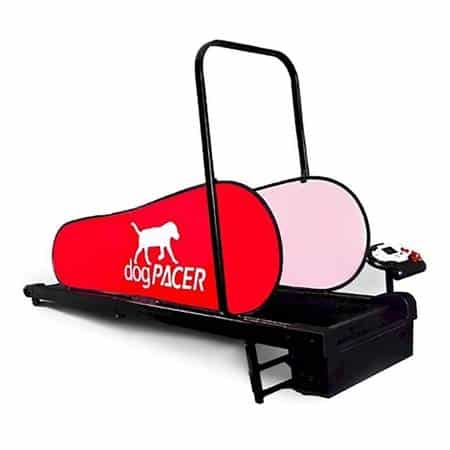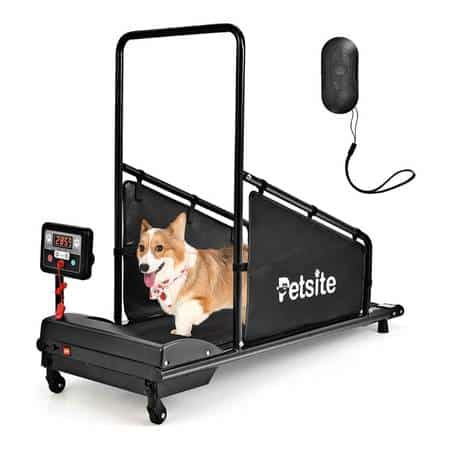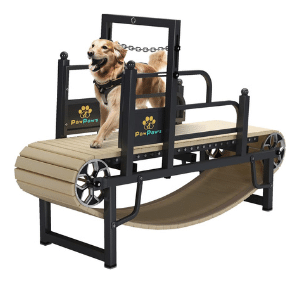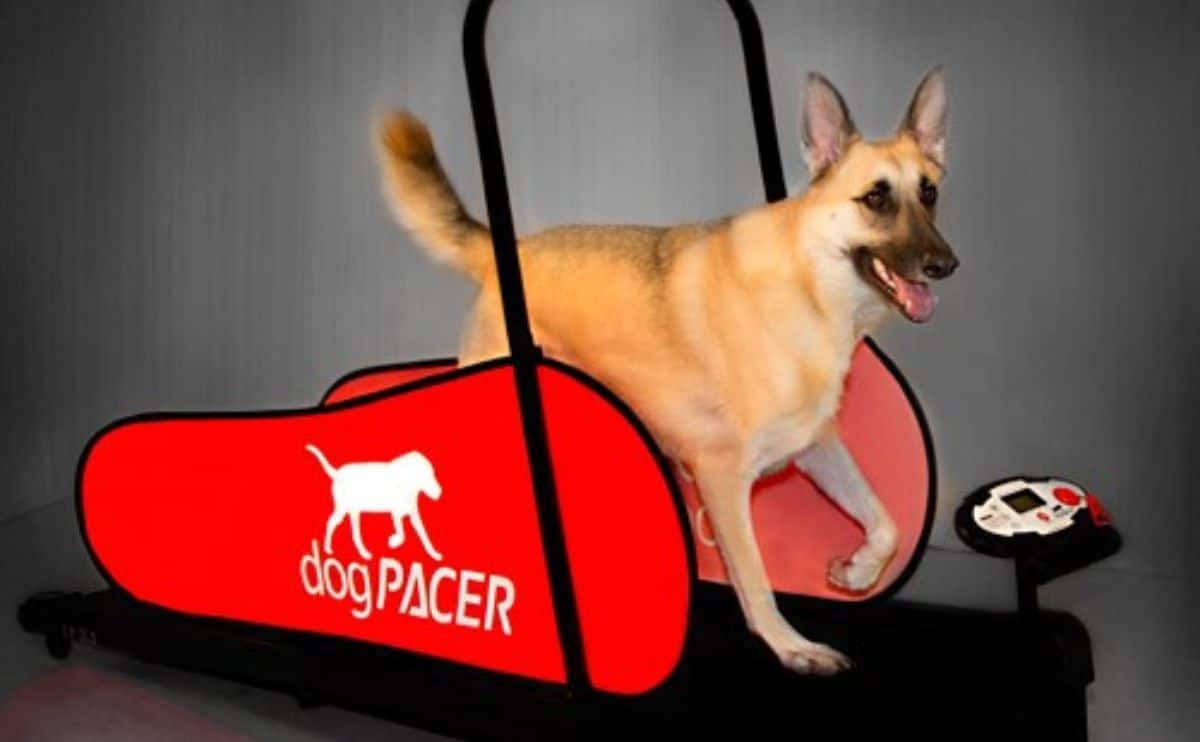4 Best Dog Treadmills: Motorized, Self-Propelled, Manual, Training Tips & More
When you purchase through links on our site, we may earn a commission. Here’s how it works.
Do you know dog treadmills can help your pooch work out and get in shape? A pet treadmill has many benefits and can help dramatically improve the quality of your dog’s life. Whether your dog’s activity levels are insatiable or you’ve got a pooch that hates going outside in the rain, there are probably more advantages to owning a dog treadmill than you’ve considered. If you’re buying a dog treadmill, there are many criteria to consider. I explore everything you need to know about treadmills for dogs, answer “Are dog treadmills safe?” and find out which one is best for your furry friend.
Table of Contents
| Winner | Runner-Up | Manual |
|---|---|---|
 |  |  |
| DogPACER | PETSITE | PawPaw’s |
| View on Amazon | View on Amazon | View on Amazon |
| Read Review | Read Review | Read Review |
Why Does My Dog Need A Treadmill? 7 Reasons
First, what are the benefits of dog treadmills? Dogs need exercise just like us. A doggy treadmill is similar to a human treadmill in that it can help keep your pup healthy when weather conditions don’t allow you to take outdoor walks. In addition to indoor exercise, below are some reasons you may want to look into a treadmill for dogs.
- Prevent Obesity. Regular exercise and a proper diet can keep your furry friend healthy and happy.
- Lower Vet Bills. Exercise improves your dog’s overall health, meaning fewer vet trips and, hopefully, a longer life.
- Reduces Allergies. If your dog (or you) suffers from allergies and can’t be outside for too long, they can still get the exercise they need at home.
- Behavioral Benefits. If your pooch has super high energy levels, a stint on the treadmill can burn excess energy and reduce unwanted behaviors like chewing, digging, barking, and much more.
- Reduce Anxiety. Exercise is a great way to reduce anxiety in dogs. Plus, having a treadmill allows you to exercise your dog when they are too fearful to go outside, such as during fireworks on the 4th of July.
- Exercise Takes Time. You may not always have time to exercise your dog outside, but you can at home.
- Rehabilitation. Whether you’re looking for a gentle stride or a powerful workout, treadmills can be helpful when recovering from injury, surgery, or muscle atrophy. Watch this quick video on how hydrotherapy using underwater treadmills can help heal dogs.
Dog Treadmill Safety
Before you purchase one of the best dog treadmills for your dog, it’s a good idea to talk to your vet about it. Ensure your dog is in good health, and a treadmill is a suitable form of exercise. If your vet okays it, be sure to read the instructions thoroughly. It’s essential to keep your dog safe and ask the manufacturer any questions before using the treadmill. Training your dog to use a treadmill might take time and lots of patience; other dogs might approach it like a duck to water.
4 Best Dog Treadmills
I have chosen a selection of dog treadmills to get your dog on their way to a tail-wagging workout. I have scoured the web to find a selection of dog cardio equipment that is high-quality, safe, good value for money, and highly rated by real customers.
Best Dog Treadmill: DogPACER Treadmill Review
DogPACER has treadmills in two sizes: a regular one for dogs up to 180 pounds and a mini dogPACER for smaller dogs up to 55 pounds. This treadmill is not a self-propelled dog treadmill; it needs a corded electric to run. It has a small motor that can get your pup up to speeds of 7.5 mph and has an adjustable incline of up to 9%. The foldable design allows for easy storage, not to clutter up your space. The metal frame comes with a lifetime warranty.
DogPACER enables you to exercise your dog indoors simply and safely. The LCD display helps you track your dog’s exercise and results, and there are five customizable running programs. The reviews for the DogPACER doggie treadmills are overwhelmingly positive. However, some customers had trouble with the motor, and despite being described as “whisper quiet,” some said it was quite noisy. However, it is one of the most popular dog treadmills on the market.
| Pros | Cons |
|---|---|
| Popular dog treadmill | Some users reported motor issues |
| Patented fold-up technology | A few customers state the motor is noisy |
| Adjustable incline | |
| Safety key | |
| 5 customizable running programs & LCD screen | |
| The metal frame comes with a lifetime warranty | |
| Excellent performance |
Price
- DogPACER LF 3.1 Treadmill: Check Amazon for availability
- DogPACER Minipacer Treadmill: Check Amazon for availability
Runner-Up Treadmill: PETSITE Dog Treadmill Review
The PETSITE Dog Treadmill is a motorized treadmill that can help you get your pooch the exercise they need indoors. This treadmill has features that are very similar to those of the DogPACER. They both have identical top speeds, incline abilities, and safety features. It can tolerate weight up to 200 pounds, more than the DogPACER option. While its weight capacity is higher than the DogPACER, larger dogs won’t fit due to height and length restrictions. Many customer reviews state it is only suitable for small to medium dogs.
The PETSITE Treadmill is my runner-up because it only comes in one size and can’t fold down for storage, unlike DogPACER. However, it could be the better option for those on a smaller budget. This treadmill has wheels to help owners move it around, and it also has 12 preset programs to help Fido get started with their workouts. I like that this option is reportedly quieter and features a remote control so owners can control the treadmill within a distance of 65.5 feet.
| Pros | Cons |
|---|---|
| Has a quiet motor | It doesn’t fold up |
| Adjustable incline & 12 preset programs | Works best for smaller dogs because of height and length restrictions |
| Safety key protection | |
| It comes with a remote control | |
| Features 2 wheels for easy portability | |
| Excellent performance |
Price
Best Manual Dog Treadmill: PawPaws Large Dog Treadmill Review

You might want to check out this treadmill for a manual dog running machine without a motor. The free-standing machine doesn’t require power, and your dog can entertain themselves (although supervision is always recommended). They can take it in their stride and stop whenever they want. There are two sizes, medium and large, and the large option is only recommended for dogs weighing 40 pounds and up. PawPaw states it only takes 20 minutes to install, although some customers found it a bit longer than this. However, they were happy with the quality once they got it up and running.
This treadmill uses high-quality materials, such as a solid carbon steel coated frame that is adjustable in three places to find the perfect height and angle for your dog. The running belt is solid wood or ABS plastic (depending on your chosen model) that mimics a real-life deck or boardwalk. It uses aluminum rollers and rubber wheels, allowing your pooch to sprint or stride. It has safety sides and a top bar to which you can attach your dog. The updated version also features a safety break, wheels for relocation, and an extra track for more stability.
| Pros | Cons |
|---|---|
| Cord-free and can use it indoors or outdoors | More expensive |
| 2 sizes (medium & large) & 2 models (standard & upgraded) | Some customers found installation longer than expected |
| Features high-quality, robust materials | |
| The frame has 3 adjustable points | |
| Quieter than motorized machines | |
| Safety training railings | |
| Excellent performance |
Price
- Starts from $879.99
Best Dog Treadwheel: GoPet Review
While not a traditional treadmill, this alternative exercise option is popular for small dogs that weigh up to 25 pounds or cats. Like the manual treadmill, it doesn’t require power, so it’s quieter. Think of it like a hamster wheel but for canines. Dogs can walk at their own pace, hop on and off, and stride to their heart’s content (no leash needed). It’s safe to use alone and has a training door to get your dog used to the wheel. It is made of plastic and is easy to clean. Although a running mat is inside the wheel to make running on it easier, a few customers said their pup didn’t like it.
| Pros | Cons |
|---|---|
| Cord-free and can be used indoors or outdoors | Only for dogs up to 25 pounds |
| Quieter than motorized machines | It can be challenging for dogs to learn since it’s not a flat dog walking surface |
| It can be used unsupervised | Pricey |
| Easy to clean | |
| Takes up less space than traditional treadmills |
Price
3 Dog Treadmill Training Tips

You’re probably wondering how to train a dog to use a treadmill, and once you do, how you can use treadmill training to exercise your pup. We have some tips to help you start.
1. Training A Dog To Use A Treadmill
Before you put your dog on the treadmill, you should allow them to explore on and around this new “toy.” Place training treats or their favorite toys next to and on the treadmill so they associate positive rewards with the dog running machine. Crouch down to their level and encourage them to hop on. Run the motor so they can get used to the sound before you put them on the treadmill. Next, put your dog on the treadmill on a leash and turn the treadmill to the lowest setting. Stand next to your pup, holding the leash as they stride. Over several sessions, slowly increase the speed to ensure your dog is comfortable and knows how to use the treadmill. Keep it fun by giving praise and treats so your dog enjoys the experience.
2. Take It Slowly
Once your dog is comfortable on the treadmill, you can allow them to run at their desired speed for 30 seconds to a minute. You can increase the speed by 30 seconds to one minute each day. Eventually, you can let them run for 15 to 30 minutes, depending on their athletic ability. Treadmill training for exercise can take several weeks before they begin to feel comfortable with it. If you force them to climb on when unsure or run longer than they want, you risk creating a negative association with the machine.
3. Never Leave Your Dog
For your dog’s safety, never leave them alone on a treadmill. This is especially important in the beginning when they are first starting to learn and use the treadmill. Staying with them will encourage and support them during their training. Like humans, even professional doggy sprinters can have an accident on a dog running machine. So, please don’t leave them unattended during a workout.
How Long Should I Put My Dog On A Treadmill?
The duration you should put your dog on a treadmill depends on several factors, including your dog’s age, breed, fitness level, health, and specific fitness goals. High-energy dogs may require longer treadmill sessions than low-energy breeds. Also, consider your dog’s age: puppies and seniors may need shorter sessions. Your reasons for using the treadmill can influence the duration. If you’re using it for healthy weight management, you might start with shorter sessions and gradually work up to longer ones. If you’re using it for maintaining their fitness, you can adapt the duration accordingly.
Pay close attention to your dog’s behavior during treadmill sessions. Signs of fatigue or distress, such as heavy panting, drooling, or stumbling, indicate that your dog may be getting tired. At this point, it’s essential to stop the session. You should also be extra cautious about using a dog treadmill if you have a flat-faced dog or brachycephalic breed, as intense and prolonged exercise isn’t always suitable. Remember to check with your vet before using a dog treadmill.
Should I Consider A Pet Wellness Or Insurance Plan?
These dog running machines are an excellent way to get your pup more exercise. If you’re concerned about ensuring your pup stays healthy, you might want to consider a pet wellness plan to help you cover the cost of staying on top of their preventative healthcare. Alternatively, you could consider pet insurance that covers accidents, illnesses, and other things. It’s another way to ensure you do everything possible to keep your pup healthy and safe. Our pet insurance expert reviews the best pet insurance for dogs and offers advice on finding the best coverage for your needs. We also provide a free quote widget below to pull prices from our top companies.
Frequently Asked Questions
I have put together a list of frequently asked questions about treadmills for dogs. If you don’t see your question below, let us know in the comments below, and we’ll find the answer for you.
Are Dog Treadmills A Good Idea?
Are treadmills good for dogs? Treadmills are an excellent tool for exercising your pup. They can be used during inclement weather and help decrease anxiety, nervousness, or boredom. They can help build a consistent exercise routine and offer additional workouts to help manage weight, among other things.
Do Dogs Like Treadmills?
Whether or not a dog likes a treadmill depends on various factors, including their personality, training, and the positive associations you create. It’s essential to prioritize your dog’s comfort and well-being throughout the process and be prepared to explore other forms of exercise if the treadmill isn’t the right fit for your furry companion. Watch this short video to see how much these seasoned pups love their treadmill.
How Much Is A Dog Treadmill?
Depending on the brand and size you pick, dog running machines can range from a few hundred dollars to over a thousand. It’s important to pick a high-quality option that is durable and safe for your dog.
Is There A Puppy Treadmill?
Puppies can be a bit clumsy, and as their bodies are still developing, you should wait until they are at least six months old to start them on a treadmill.
Do I Need A Harness?
Using a dog treadmill harness is debatable. Some trainers say it can be dangerous, while others believe attaching a leash from each side of the treadmill to a harness keeps the dog in the machine’s center and prevents him from falling off. This is a personal choice and something you should discuss with your vet.
How Do I Get A Scared Dog On A Treadmill?
Want to know how to get a scared dog on a treadmill? Start slow and be consistent. Use treats to get your dog to stand on the machine while it’s off, and praise them when they get on. Once they become more comfortable, see if you can get them to walk slowly on the treadmill. Again, use treats and praise to encourage a positive response. Over time, you can increase the speed as long as they are doing well. With a scared pup, slow, consistent exposure works best.
How Do I Get My Dog To Run On A Treadmill?
You can put a dog on a treadmill and hope for the best, but it’s a little different if you want to know how to get your dog to run on a treadmill. Once your pup is comfortable getting on the treadmill, slowly increase the speed each time they use it until they reach a running pace.
Can Dogs Walk On Treadmills?
Yes, dogs can walk on treadmills. They can keep whatever pace is comfortable, from walking to running.
Other Ways To Keep Your Dog Healthy
There are plenty of ways to keep your dog healthy. Whether a dog treadmill is the right workout for your pup, there are also other activities to try. Barn hunting is a popular physical activity for dogs to stimulate their body and minds. Investing in interactive dog toys can boost their mental and physical health, as well as bonding with you. Last but not least, one of my favorites, is a flirt pole for dogs. My energetic Doxie loves playing with this toy, and it’s a quick way to burn excess energy when you are short of time.
Have you used any of these dog treadmills? Perhaps you have another dog cardio machine to keep your pup healthy that you think I should consider adding to my list. Let us know in the comments below.
Why Trust Canine Journal?
Emma is a dog mom to two rescue dogs, Bonkers and Chips. She has decades of canine experience, from volunteering at her local shelters to being a professional dog walker and sitter. Emma knows the importance of keeping dogs fit for both their physical and mental health. But with the pressure of busy day-to-day life, it’s not always possible to walk your dogs as they need daily. This, among other reasons, is where the dog treadmill steps in. Emma is passionate about sharing her experience and knowledge with other dog parents to help them live a happy and healthy life together. She works with a dedicated team at Canine Journal to provide their readers with all the information they need to achieve this.




